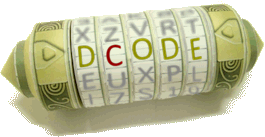Tool/solver to resolve one or more equations. An equation is a mathematical expression presented as equality between two elements with unknown variables.
Equation Solver - dCode
Tag(s) : Symbolic Computation
dCode is free and its tools are a valuable help in games, maths, geocaching, puzzles and problems to solve every day!
A suggestion ? a feedback ? a bug ? an idea ? Write to dCode!
Equation Solver
Equation Solver Calculator
Solve a Differential Equation
Solve a Boolean Equation
Answers to Questions (FAQ)
What is an equation? (Definition)
An equation is a mathematical equality between two expressions separated by an equal sign =. Each of these expressions can contain numbers, variables (called unknowns), or operations.
How to solve an equation?
The dCode calculator allows you to solve equations (and also inequalities) to find their unknowns. An equation must contain a comparison sign, usually = (or < or >).
Example: $ 2x=1 $ returns for solution $ x = 1/2 $
dCode returns exact solutions (integers, fraction, etc.) by default (for linear and nonlinear equation systems), if the equation contains floating point numbers. then dCode will return a solution with decimal numbers.
Example: $ 2x = 1.0 $ returns for solution $ x = 0.5 $
To solve a cryptarithm (replacing letters with multiple values between 0 and 9), use the dCode cryptarithm solver.
How to solve multiple equations?
To solve multiple equations at the same time (a system of equations), separate them with the logical operator && or ⋀, or place each equation on a separate line.
Example: The equation system of first and second degree 2x^2+1 = 3 && 3x-1 = 2 gives x=1
How to solve multiple equations with multiple variables?
To solve a system of equations, the solver expects each equation to be on a new line or on a single line but separated by && or ⋀. Then enter the unknowns to be found in the field provided.
How to check an equality?
Use the dedicated tool to check an equality or else, enter the equation and click on solve, the solver will answer true if the equality is checked whatever the variable (there are an infinite number of possible solutions for the variable).
Example: 2n+18n+4=2(n+9n+2) is TRUE for any value of n
The solver will return false if equality is not possible (if there is no solution for the variable)
Example: 5(x-7)=3(x+2)+2x is FALSE for any value of x
How to add an interval or a domain of resolution?
To restrict the search for solutions to a particular domain, add an additional condition after the equation.
Example: $ x^2-2 = 0 \ \&\& \ x > 0 $ if the equation is valid only on $ x > 0 $ strictly positive numbers.
How to solve an equation step by step?
The solver doesn't show the steps because, like a calculator, it displays the result directly without going through the manual developments. It uses internal mathematical shortcuts, and the intermediate steps simply don't exist in its calculation mode.
Source code
dCode retains ownership of the "Equation Solver" source code. Any algorithm for the "Equation Solver" algorithm, applet or snippet or script (converter, solver, encryption / decryption, encoding / decoding, ciphering / deciphering, breaker, translator), or any "Equation Solver" functions (calculate, convert, solve, decrypt / encrypt, decipher / cipher, decode / encode, translate) written in any informatic language (Python, Java, PHP, C#, Javascript, Matlab, etc.) or any database download or API access for "Equation Solver" or any other element are not public (except explicit open source licence). Same with the download for offline use on PC, mobile, tablet, iPhone or Android app.
Reminder: dCode is an educational and teaching resource, accessible online for free and for everyone.
Cite dCode
The content of the page "Equation Solver" and its results may be freely copied and reused, including for commercial purposes, provided that dCode.fr is cited as the source (Creative Commons CC-BY free distribution license).
Exporting the results is free and can be done simply by clicking on the export icons ⤓ (.csv or .txt format) or ⧉ (copy and paste).
To cite dCode.fr on another website, use the link:
In a scientific article or book, the recommended bibliographic citation is: Equation Solver on dCode.fr [online website], retrieved on 2025-12-25,
- Equation Solver Calculator
- Solve a Differential Equation
- Solve a Boolean Equation
- What is an equation? (Definition)
- How to solve an equation?
- How to solve multiple equations?
- How to solve multiple equations with multiple variables?
- How to check an equality?
- How to add an interval or a domain of resolution?
- How to solve an equation step by step?
